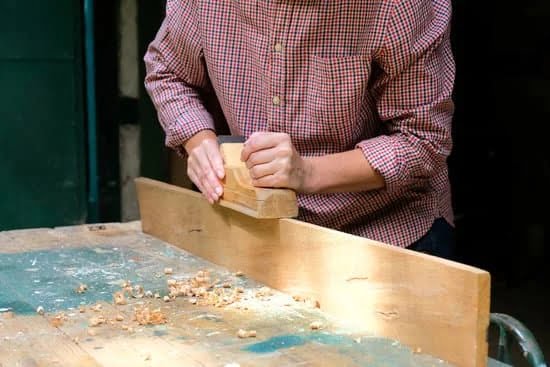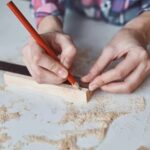Is your beautiful woodwork full of unsightly scratches? Whether it’s surface scratches, deep gouges, or dents, knowing how to repair scratched woodwork is crucial to maintaining the natural beauty of your wooden surfaces. By understanding the types of wood scratches and learning the best approach for repair, you can restore your woodwork to its former glory.
The first step in repairing scratched woodwork is to identify the type of scratch and assess the damage. This involves differentiating between surface scratches, deep gouges, and dents, as well as determining the type of wood and finish in order to choose the most effective repair method.
Once you’ve identified the type and extent of the scratches, it’s essential to gather the necessary materials for the repair process. From wood fillers and putties to sandpaper and touch-up products, having the right materials on hand is key to achieving a seamless repair. So let’s dive into understanding the types of wood scratches and how best to approach their repair.
Assessing the Damage
When it comes to repairing scratched woodwork, the first step is to assess the damage. This involves thoroughly inspecting the extent of the scratches and determining the overall condition of the woodwork. It is essential to differentiate between surface scratches, deep gouges, and dents. Surface scratches are minor and only affect the top layer of the wood, while deep gouges penetrate deeper into the wood. Dents, on the other hand, are depressions in the wood caused by impact.
In addition to identifying the type of scratches, it is crucial to also examine any underlying issues that may have caused the scratches. This can include factors such as improper use or maintenance of furniture, contact with sharp objects, or even pet damage. Understanding the cause of the scratches will help in determining an appropriate repair approach.
Once you have assessed the damage and determined the type of scratches present on your woodwork, you can then proceed with preparing for repair. This may involve gathering materials such as wood fillers, sandpaper, and touch-up products specifically designed for wood surfaces. It is important to take note of these necessary materials and ensure that you have everything you need before starting the repair process.
| Wood Type | Scratch Type |
|---|---|
| Oak | Surface Scratches |
| Pine | Deep Gouges |
| Cherry | Dents |
Gathering the Necessary Materials
When it comes to repairing scratched woodwork, having the right materials is crucial for achieving a successful outcome. Before starting the repair process, it’s important to make sure you have all the necessary items on hand. Here are some tips for gathering the right materials:
Listing Out the Materials Needed for Repairing Scratched Woodwork
Before you begin repairing scratched woodwork, it’s essential to make a list of the materials you’ll need. This may include wood fillers or putties, sandpaper of various grits, a wood finish that matches your existing finish, polishing and buffing compounds, and any specific tools required for your repair job. Having a comprehensive list will help ensure that you don’t miss anything when you begin the repair process.
Providing Tips for Sourcing the Right Products and Tools for the Job
When sourcing materials for repairing scratched woodwork, it’s important to choose high-quality products and tools that are suitable for the type of damage you’re dealing with. For example, if you have deep gouges in your woodwork, you’ll want to select a durable and reliable wood filler that can effectively fill in the damaged area. Additionally, be sure to choose a wood finish that closely matches your existing finish to achieve a seamless result.
Once you have gathered all the necessary materials, you’ll be well-prepared to move on to the next steps of preparing and repairing the scratched woodwork. Whether you’re dealing with surface scratches or deep gouges, having the right materials at your disposal is key to successfully restoring your wood surfaces to their former glory.
Preparing the Wood Surface
When it comes to repairing scratched woodwork, one of the most crucial steps in the process is preparing the wood surface for the repair. Properly prepping the area will ensure that the repair is seamless and long-lasting. Here’s a step-by-step guide on how to prepare the wood surface for repair:
- Start by thoroughly cleaning the scratched area with a mild soap and water solution. This will remove any dirt, grime, or residue from the surface.
- After cleaning, use a fine-grit sandpaper to gently sand the scratched area in the direction of the wood grain. This will smooth out any rough edges and prepare the surface for filling.
- Once the area is sanded, wipe away any dust and debris with a clean, damp cloth. It’s important to ensure that the surface is completely clean before moving on to the next step.
Properly preparing the wood surface sets the foundation for a successful repair. By cleaning and sanding the scratched area, you create a smooth canvas for filling in the scratches and repairing the finish.
It’s important to note that different types of wood and finishes may require specific preparation techniques, so be sure to research or consult with a professional if you’re unsure of how to proceed with your particular type of woodwork.
Ultimately, taking care during this preparation stage will contribute significantly to achieving a flawless result when repairing scratched woodwork.
Filling in the Scratches
When it comes to repairing scratched woodwork, one of the crucial steps is filling in the scratches. Whether you are dealing with surface scratches or deep gouges, there are different methods and products that can be used to effectively repair the damage.
For surface scratches, using a wood filler or putty can help smooth out the area and restore the wood’s appearance. On the other hand, for deeper gouges, using a combination of wood fillers and putties may be necessary to properly fill in the damaged area.
One key tip for filling in scratches is to ensure that the chosen filler or putty matches the color of the wood as closely as possible. This will help to blend the repaired area seamlessly with the rest of the woodwork. Additionally, following manufacturer instructions for applying and drying times is essential to achieve a professional-looking result.
| Wood Filler/Putty | Recommended Use |
|---|---|
| Minwax Wood Putty | Ideal for small repairs and minor scratches |
| Bondo Wood Filler | Best for deeper gouges and larger repair areas |
| J-B Weld KwikWood Epoxy Putty Stick | Great for versatile use on different types of wood damage |
By choosing the right filler or putty and following proper application techniques, you can effectively fill in scratches on your woodwork and restore its original beauty. Remember that patience and attention to detail are key when it comes to achieving a seamless repair.
Repairing the Finish
Once the scratches on your woodwork have been filled in, the next step is to repair the finish. This is crucial for achieving a seamless and professional-looking result. Here are the steps to take when repairing the finish on scratched woodwork:
1. Matching the Wood Finish: Before applying any touch-up products, it’s important to accurately match the wood finish. This may involve identifying the type of finish (e.g. varnish, lacquer, or shellac) and determining its sheen level (e.g. matte, satin, or gloss). Once you have this information, you can purchase a matching touch-up product from your local hardware store.
2. Applying Touch-Up Products: Using a small brush or cloth, apply the touch-up product to the repaired area in thin layers. Be sure to follow the manufacturer’s instructions for best results. Allow each layer to dry completely before applying the next one.
3. Blending with Surrounding Woodwork: To ensure that the repaired area seamlessly blends with the rest of the woodwork, carefully feather out the touch-up product beyond the filled-in scratches. This will help to camouflage any differences in color or sheen between the repaired spot and its surroundings.
By following these steps for repairing the finish on scratched woodwork, you can achieve a professional-looking result that restores your wood surfaces to their former glory.
Buffing and Polishing
After successfully filling in the scratches and repairing the finish of your woodwork, the next step is to buff and polish the area to achieve a smooth and flawless finish.
Importance of Buffing and Polishing
Buffing and polishing are essential steps in the wood repair process as they help blend the repaired area seamlessly with the rest of the woodwork. This final step not only enhances the appearance of the repaired surface but also ensures that it matches the overall sheen and texture of the surrounding wood. Proper buffing and polishing can make a significant difference in achieving a professional-looking result.
Steps for Buffing and Polishing
To buff and polish the repaired wood surface, start by lightly sanding it with fine-grit sandpaper to smooth out any uneven areas. Next, apply a small amount of wood polish or wax to a clean cloth or applicator pad.
Gently rub the polish onto the repaired area in circular motions, gradually working your way outwards to blend it with the surrounding wood. Allow the polish to dry according to the product instructions before buffing it with a soft, clean cloth until it achieves a lustrous shine.
By following these steps for buffing and polishing, you can ensure that your repaired woodwork looks seamless and professionally done. Remember that patience and attention to detail are key when performing this final step in repairing scratched woodwork.
Preventing Future Scratches
In conclusion, knowing how to repair scratched woodwork is a valuable skill for maintaining the beauty and longevity of your wooden furniture, floors, and fixtures. By understanding the different types of wood scratches and assessing the damage, you can effectively determine the best approach for repair. Gathering the necessary materials, preparing the wood surface, filling in the scratches, repairing the finish, buffing and polishing, and preventing future scratches are all important steps in achieving a professional-looking result.
When it comes to repairing scratched woodwork, one of the most crucial aspects is preparing the wood surface before any repairs are made. This includes cleaning and sanding the scratched area to ensure that it is properly prepped for filling in the scratches and repairing the finish. Additionally, using recommended wood fillers and putties will help to seamlessly blend the repaired area with the rest of the woodwork.
Finally, once you have completed the repair process, it’s important to take proactive measures to prevent future scratches on your woodwork. Regular maintenance and applying protective measures such as felt pads on furniture legs or using area rugs on hardwood floors can go a long way in preserving the integrity of your wood surfaces.
By following these steps and recommendations for repairing scratched woodwork and preventing future damage, you can ensure that your wood surfaces stay looking their best for years to come.
Frequently Asked Questions
How Do You Fix Scratched Wood Trim?
To fix scratched wood trim, you can start by cleaning the damaged area with a wood cleaner or a mixture of vinegar and water. Then, apply a wood filler to the scratch, let it dry, and sand it down until smooth. Finally, touch up the area with matching stain or paint.
How Do You Fix Scratches on Wood Frames?
Fixing scratches on wood frames involves first cleaning the area and then using a wood marker or touch-up pen to color in the scratch. If the scratch is deeper, you may need to use a wood filler to fill in the gap before applying the touch-up solution.
How Do You Get Scratches Out of Wood Without Sanding It?
If you want to remove scratches from wood without sanding, there are a few methods to try. One option is to use a combination of olive oil and vinegar to rub into the scratch and surrounding area.
Another method involves using a walnut or pecan to rub along the scratch, allowing the natural oils from the nut to mask the scratch.

Hi everyone! I’m a woodworker and blogger, and this is my woodworking blog. In my blog, I share tips and tricks for woodworkers of all skill levels, as well as project ideas that you can try yourself.





